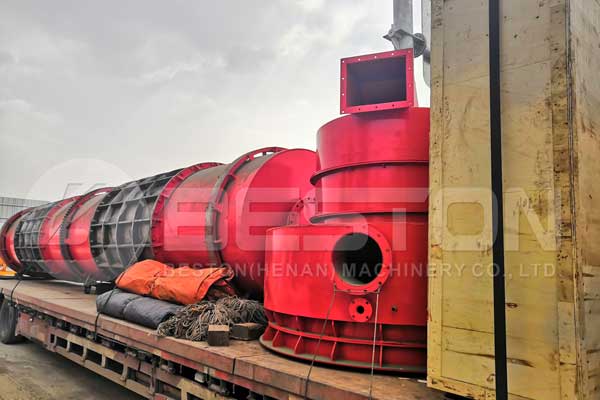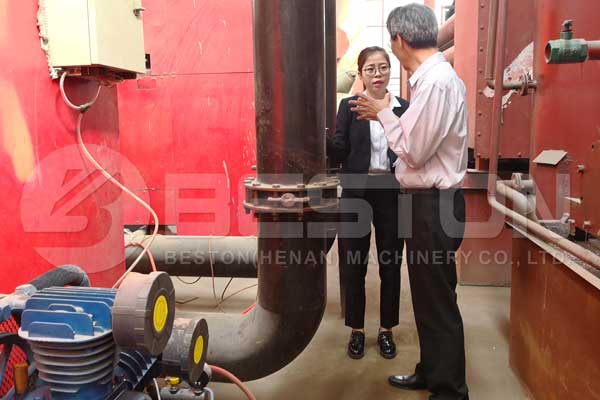Biochar Production Equipment – Helps to Hand the Disposal Of Sewage Sludge
In order to curb water pollution, there have been developments including wastewater treatment by wastewater treatment plants which have been effective in containing wastewater. But as a result, there has been the production of sewage sludge which consists of water, organic and mineral solids which are pollutants in wastewater. Problems have arisen on how to effectively deal with the sewage sludge resulting from wastewater treatment in an eco-friendly way. This has led to the development of sewage sludge treatment systems which help in handling the disposal of sewage sludge.
Composition of sewage sludge
Sewage sludge consists of organic and inorganic materials, organic chemicals, major elements such as nitrogen, calcium, magnesium, potassium and trace elements such as mercury, lead, zinc, selenium and copper. Sludge is also composed of plant nutrients and some pathogens as a result of microbial activity.

Process of sewage sludge treatment
After the production of sewage sludge by water treatment plants, it is pumped to an offsite place where treatment is carried out. The rice husk carbonizer involves different processes as below;
1.Sludge stabilization
This involves the process of decomposing of organic solids into stable substances, reduction of pathogens. This is achieved by the addition of chemicals into the sludge and thus inhibiting the growth of microorganisms.
This results in volume reduction in overall volume, elimination of bad odors as a result of microbial activity and also the production of methane gas which can be reused.
Stabilization is achieved by different processes including;
•Anaerobic digestion; this involves the decomposition of organic acids in the absence of oxygen resulting in the production of carbon dioxide and methane gas by the processes of hydrolysis, acidogenesis, acetogenesis and methanogenesis. This increases the solid content, reduces the number of pathogens and maintains the available plant nutrients.
•Aerobic digestion; this involves the supply of sludge with oxygen allowing the microorganisms to feed on the sludge and once it’s depleted, they start feeding on their phytoplasm to produce energy.as a result the cell tissue is oxidised to produce ammonia, water and carbon dioxide. This results in the reduction of nitrogen and reduction of volatile solids. More information on sawdust charcoal making machine here.
•Pasteurization; this involves the heating of the sludge contents at a temperature of 70 degrees for a period of 30 minutes resulting in the destruction of pathogens.

2. Sludge dewatering and thickening
This process involves the removal of water from the liquid sludge resulting in a reduction of the volume of sludge to almost half its original volume. This involves three processes as below;
- Thickening; it involves the use of around gravity tank whereby the sludge is poured and allowed to settle allowing the thick sludge to settle on the bottom while the less dense sludge settles on the top. The thickened sludge is collected from the bottom of the tank. Thickening can also be achieved by the introduction of air into the sludge allowing water to escape thus enabling the high-density sludge to settle on the bottom.
- Dewatering; it involves the removal of moisture from the sludge content making it easier to handle. This is achieved by either air drying on drying beds, centrifugation or belt pressing. Drying beds are preferred in the dewatering process due to their efficiency, high quality of the end product, low costs and do not require a lot of monitoring.
- Carbonization Process. The carbonization process is a very important method to turn waste sludge into energy and fuel. It is a high-temperature and zero-oxygen process. You can get charcoal from the process from the waste sludge. See bamboo charcoal machine here.
3.Sludge disposal
Sewage sludge disposal can be done in different ways which each having both positive and negative outcomes. The most common ways of sewage disposal include;
•Incineration
- Sewage sludge incineration has various advantages such as reduction of the heavy metal content by concentrating it in the ash, it enables phosphorus recovery, complete reduction of pathogens and allows chemical materials to decompose completely.
- Some of the disadvantages of sludge incineration include the loss of nitrogen, release of carbon dioxide into the atmosphere and it is quite expensive.
•Landfilling
Landfilling is a simple process and environmentally friendly process as it combats the spread of the pollutants. However, landfilling is associated with disadvantages such as the limited recovery of the nutrients, leaching of contaminants to groundwater that can lead to serious health effects and also release of unpleasant odours to the environment.
•Agricultural application
- Agricultural application has the advantages of obtaining cheap fertilizers, allowing complete nutrient recovery and also low disposal costs.
- Some of the disadvantages involved with the agricultural application include the addition of heavy metals into the soil and spread of the pathogens contained in the sewage sludge.
There are a lot of other charcoal machine that can turn waste into biochar, if you are interested in it, click it now.